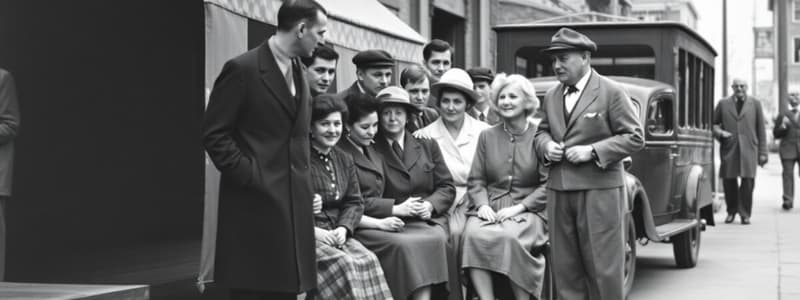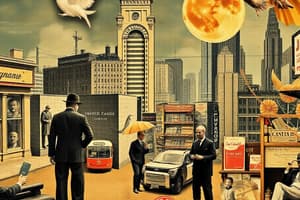Podcast
Questions and Answers
How did the increased availability of consumer credit impact American society during the Roaring Twenties?
How did the increased availability of consumer credit impact American society during the Roaring Twenties?
- It led to a decrease in demand for new household appliances due to high interest rates.
- It caused a decline in the manufacturing industry as people relied more on credit than cash.
- It primarily benefited wealthy individuals and had little impact on the average American family.
- It enabled more Americans to purchase new household appliances and participate in consumer culture. (correct)
In what way did the role of women in the workforce shift during and after World War I?
In what way did the role of women in the workforce shift during and after World War I?
- Women were excluded from war-related jobs and primarily focused on domestic duties.
- Women entered the workforce in large numbers, filling jobs vacated by men and remaining employed after the war. (correct)
- Women were limited to traditional roles, such as nursing, and did not experience significant changes in employment opportunities.
- Women's participation in the workforce decreased as men returned from the war and reclaimed their jobs.
Which factor most significantly contributed to the expansion of the American Dream in the early 1900s?
Which factor most significantly contributed to the expansion of the American Dream in the early 1900s?
- Widespread adoption of agrarian lifestyles.
- Technological and manufacturing boom. (correct)
- Increased government regulation of businesses.
- Decline in international trade.
What was a primary consequence of the Dust Bowl during the Great Depression?
What was a primary consequence of the Dust Bowl during the Great Depression?
How did the radio contribute to the changing culture landscape of the 1920s?
How did the radio contribute to the changing culture landscape of the 1920s?
Which set of factors contributed to the immense suffering experienced by the Silent (Lost) Generation?
Which set of factors contributed to the immense suffering experienced by the Silent (Lost) Generation?
What was the most significant contributor to the economic instability of the 1930s?
What was the most significant contributor to the economic instability of the 1930s?
Which set of events characterized the traumas of the 1930s?
Which set of events characterized the traumas of the 1930s?
Which of the following best describes the economic situation that directly contributed to the rise of a consumer culture among the Baby Boomer generation?
Which of the following best describes the economic situation that directly contributed to the rise of a consumer culture among the Baby Boomer generation?
How did the economic prosperity experienced by the Baby Boomer generation directly affect their approach to education, as compared to the 'Silent Generation'?
How did the economic prosperity experienced by the Baby Boomer generation directly affect their approach to education, as compared to the 'Silent Generation'?
Which factor most directly contributed to the decline in birth rates that led to Generation X being called the 'baby bust' generation?
Which factor most directly contributed to the decline in birth rates that led to Generation X being called the 'baby bust' generation?
The experience of growing up as 'latchkey kids' had what primary impact on Generation X?
The experience of growing up as 'latchkey kids' had what primary impact on Generation X?
How did the experience of the 'Silent Generation' during the Great Depression most directly influence their priorities and values following World War II?
How did the experience of the 'Silent Generation' during the Great Depression most directly influence their priorities and values following World War II?
How did the Vietnam War and the draft significantly shape the political views and actions of the Baby Boomer generation?
How did the Vietnam War and the draft significantly shape the political views and actions of the Baby Boomer generation?
Compared to their parents, how did Baby Boomers' engagement with institutions like churches and political parties typically differ?
Compared to their parents, how did Baby Boomers' engagement with institutions like churches and political parties typically differ?
What was a significant, long-lasting economic consequence faced by Generation X due to rising college tuition rates in the 1980s?
What was a significant, long-lasting economic consequence faced by Generation X due to rising college tuition rates in the 1980s?
How did the increased number of working women during the Great Depression primarily impact traditional gender roles within American families?
How did the increased number of working women during the Great Depression primarily impact traditional gender roles within American families?
Which of the following best characterizes the employment conditions experienced by the 'Silent Generation' as they entered the workforce following World War II?
Which of the following best characterizes the employment conditions experienced by the 'Silent Generation' as they entered the workforce following World War II?
Considering the historical context, what best explains why many members of Generation X were less likely to be financially better off than their parents?
Considering the historical context, what best explains why many members of Generation X were less likely to be financially better off than their parents?
Which of the following best summarizes the impact of the draft lottery on American youth during the Vietnam War era?
Which of the following best summarizes the impact of the draft lottery on American youth during the Vietnam War era?
Following World War II, what major lifestyle shift contributed to the growth of suburbs, and why?
Following World War II, what major lifestyle shift contributed to the growth of suburbs, and why?
What was a key contributing factor to the rise of dual-income families during the Generation X period?
What was a key contributing factor to the rise of dual-income families during the Generation X period?
Which of the following most accurately describes the financial outlook for Generation X compared to previous generations?
Which of the following most accurately describes the financial outlook for Generation X compared to previous generations?
Flashcards
Pre-Depression Generation
Pre-Depression Generation
The generation born from 1900 to 1927, experiencing the economic boom and cultural shifts of the 1920s.
American Dream (1920s)
American Dream (1920s)
The idea that people can achieve a better life than their parents through hard work and determination.
Consumer Culture (1920s)
Consumer Culture (1920s)
Increased availability of electricity and credit, which led to demand for new products.
Radio (1920s)
Radio (1920s)
Signup and view all the flashcards
Women in the Workforce (1920s)
Women in the Workforce (1920s)
Signup and view all the flashcards
Silent/Greatest Generation
Silent/Greatest Generation
Signup and view all the flashcards
Traumas of the 1930s
Traumas of the 1930s
Signup and view all the flashcards
Great Depression in the US
Great Depression in the US
Signup and view all the flashcards
Hoovervilles
Hoovervilles
Signup and view all the flashcards
Silent/Lost Generation
Silent/Lost Generation
Signup and view all the flashcards
Post WWII Stability
Post WWII Stability
Signup and view all the flashcards
Baby Boomers
Baby Boomers
Signup and view all the flashcards
Post-WWII Manufacturing Boom
Post-WWII Manufacturing Boom
Signup and view all the flashcards
Consumer Culture
Consumer Culture
Signup and view all the flashcards
Woodstock
Woodstock
Signup and view all the flashcards
Vietnam Draft Lottery
Vietnam Draft Lottery
Signup and view all the flashcards
26th Amendment
26th Amendment
Signup and view all the flashcards
Disengagement with Institutions
Disengagement with Institutions
Signup and view all the flashcards
Generation X
Generation X
Signup and view all the flashcards
"Baby Bust" Generation
"Baby Bust" Generation
Signup and view all the flashcards
Latchkey Kids
Latchkey Kids
Signup and view all the flashcards
Rising College Tuition
Rising College Tuition
Signup and view all the flashcards
Gen X Demographics
Gen X Demographics
Signup and view all the flashcards
Study Notes
- Generations are defined by the shared experiences and historical events that shape their values and perspectives.
Pre-Depression Generation (Roaring Twenties) - 1900 to 1927
- This generation witnessed significant change and the start of a modern consumer culture.
- The American Dream emerged as a pursuit of upward mobility and a better life.
- Technological advancements brought new household appliances like refrigerators, vacuum cleaners, and washing machines.
- Increased access to credit allowed more Americans to afford these goods.
- The advertising industry and marketing techniques fueled demand for products.
- Radio became a popular form of entertainment and an effective advertising medium, reaching 40% of homes by 1930.
- Women entered the workforce in large numbers during World War I and many remained employed afterward.
- Those who lived through the 1920s experienced the suffering of war, economic depression, and homelessness.
Silent (Lost) Generation/The Greatest Generation - 1928 to 1946
- The 1930s was a terrifying decade marked by economic disorder, totalitarianism, and war.
- The Great Depression in the United States led to bank failures and widespread joblessness.
- A severe drought in the Great Plains created the Dust Bowl, displacing 2.5 million people.
- Many people migrated to California seeking a better life, but faced scarce work and low wages.
- "Hoovervilles" emerged as shelters for homeless families.
- Thousands of teens became drifters, marriages were postponed, and birth rates declined.
- The number of women in the workplace increased, which helped families but challenged traditional gender roles.
- This generation experienced the Great Depression in childhood and World War II in their early twenties.
- Following World War II, they desired stability in their homes, jobs, and families.
- They sought stability through marriage, union jobs, suburban homes, and large families, leading to the Baby Boom.
Baby Boomers Generation - 1946 to 1964
- They lived during a booming American and world economy following World War II.
- The United States became the main global manufacturer, leading to many job opportunities and very low unemployment.
- A surplus of disposable income fueled a thriving consumer culture.
- Families purchased homes in the suburbs with amenities like yards, multiple bedrooms, and family cars.
- Luxury items such as colored TVs, gas-powered lawnmowers, and air conditioners became popular.
- Disposable income allowed many Baby Boomers to afford to send their children to college.
- This generation is associated with hippie culture, protests against the Vietnam War, and the Woodstock concert in 1969.
- The Vietnam War draft in 1969 highlighted the political power of the baby boom generation.
- Protests against the war contributed to the U.S.’s withdrawal from Vietnam.
- The Twenty-sixth Amendment in 1971 lowered the voting age to 18, reflecting the baby boom's political influence.
- Baby Boomers were less likely to participate in institutions like church, marriage, and political parties.
Generation X - 1965 to 1980
- This generation experienced declining birth rates after the Baby Boom, sometimes called the "baby bust".
- More dual-income families, single-parent households, and children of divorce were present during their upbringing.
- Many Gen Xers were latchkey kids, returning to empty homes after school.
- They were the first generation to grow up with personal computers, gaming systems, and cable TV.
- College tuition rates soared, resulting in substantial student loan debt.
- Many Gen Xers experienced unemployment or underemployment and had to move back in with their parents as adults.
- They may be the first generation not to achieve greater financial success than their parents.
- Generation X is more ethnically diverse, less involved in organized religion, and more liberal on social issues.
Studying That Suits You
Use AI to generate personalized quizzes and flashcards to suit your learning preferences.
Description
Overview of the Pre-Depression (Roaring Twenties) and Silent Generations, shaped by shared experiences and historical events. Focus on the rise of consumer culture, technological advancements, and the American Dream. Radio becomes popular, women enter the workforce.




